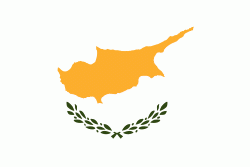Akrotiri Peninsula (Akrotíri)
The Akrotiri Peninsula is a short peninsula which includes the southernmost point of the island of Cyprus. It is bounded by Episkopi Bay to the west and Akrotiri Bay to the east and has two capes to the south-west and south-east, known as Cape Zevgari and Cape Gata.
The most prominent features of the peninsula are the Akrotiri Salt Lake and the aerodrome, which is RAF Akrotiri and Limassol BBC Relay.
In December 2018, a Byzantine church with mosaics including inscriptions in perfect condition dating back to the reign of Emperor Heraclius was discovered during the twelfth excavation season by the Department of Antiquities of Cyprusat the site of Katalymata ton Plakoton, according to an Athens Macedonia News Agency. The Greek Christian inscription described a text “My Lord help those who honor your name”.
The peninsula, including a variety of wetlands, coastal scrub, dunes and the Episkopi cliffs, has been recognised as an Important Bird Area (IBA) by BirdLife International because it supports breeding, wintering or passage migrant populations of several bird species. The wetlands to the north of the Akrotiri Salt Lake contain evidence for Bronze Age climate change.
The most prominent features of the peninsula are the Akrotiri Salt Lake and the aerodrome, which is RAF Akrotiri and Limassol BBC Relay.
In December 2018, a Byzantine church with mosaics including inscriptions in perfect condition dating back to the reign of Emperor Heraclius was discovered during the twelfth excavation season by the Department of Antiquities of Cyprusat the site of Katalymata ton Plakoton, according to an Athens Macedonia News Agency. The Greek Christian inscription described a text “My Lord help those who honor your name”.
The peninsula, including a variety of wetlands, coastal scrub, dunes and the Episkopi cliffs, has been recognised as an Important Bird Area (IBA) by BirdLife International because it supports breeding, wintering or passage migrant populations of several bird species. The wetlands to the north of the Akrotiri Salt Lake contain evidence for Bronze Age climate change.
Map - Akrotiri Peninsula (Akrotíri)
Map
Country - Cyprus
 |
 |
| Flag of Cyprus | |
The earliest known human activity on the island dates to around the 10th millennium BC. Archaeological remains include the well-preserved ruins from the Hellenistic period such as Salamis and Kourion, and Cyprus is home to some of the oldest water wells in the world. Cyprus was settled by Mycenaean Greeks in two waves in the 2nd millennium BC. As a strategic location in the Eastern Mediterranean, it was subsequently occupied by several major powers, including the empires of the Assyrians, Egyptians and Persians, from whom the island was seized in 333 BC by Alexander the Great. Subsequent rule by Ptolemaic Egypt, the Classical and Eastern Roman Empire, Arab caliphates for a short period, the French Lusignan dynasty and the Venetians was followed by over three centuries of Ottoman rule between 1571 and 1878 (de jure until 1914).
Currency / Language
| ISO | Currency | Symbol | Significant figures |
|---|---|---|---|
| EUR | Euro | € | 2 |
| ISO | Language |
|---|---|
| EN | English language |
| EL | Greek language |
| TR | Turkish language |















